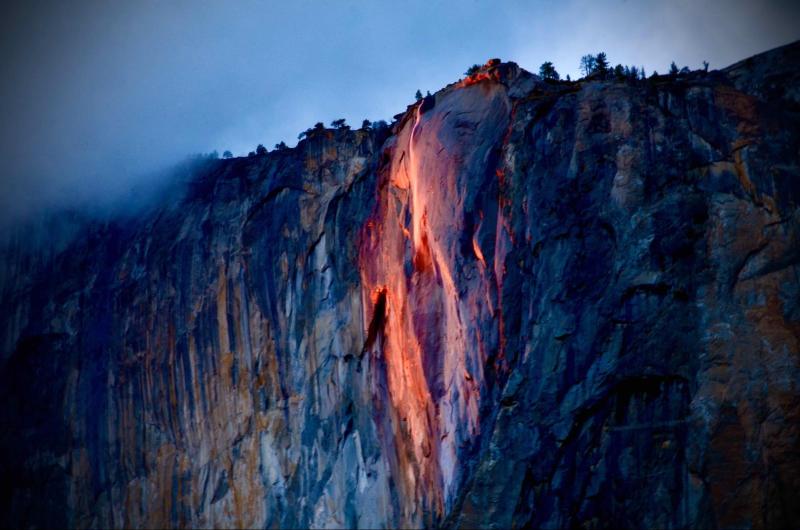For most of us on the West Coast, the incredible beauty of the national parks is something not to be taken for granted. This month, the amazing things that nature can offer are taken to the next level.
For many years, the number of spectators at Yosemite National Park has heightened around February. Hundreds, if not thousands, make their way to see the mesmerizing “firefall” phenomenon at the eastside of El Capitan. No one really knows who was the first to notice this sight. The late photographer Ansel Adams, who spent most of his life photographing Yosemite National Park, took a photograph of a glowing Horsetail Fall in 1940, but the news of this occurrence didn’t spread until National Geographic photographer Galen Rowell documented it in 1973.
The firefall is not always visible. The seasonal waterfall, namely the Horsetail Fall, only flows when there is enough rain or a melting snowpack. The sky has to be clear as to have no clouds obscuring the sun’s rays, and the timing has to be right for the sunlight to hit the water just at the right angle, which happens to be in the middle of February. When all these conditions are met, the water flow ignites as the sun dips beneath the horizon. Its glistening appearance is like lava flowing down the rocks. Dazzling. By then you know that you’re in for a show.
Why don’t we see this at other waterfalls? As it turns out, the Horsetail Fall is relatively visible. Most waterfalls are located within an amphitheater. In a blog post, landscape photographer Michael Frye explained that there are not that many waterfalls that fit the criteria for the illumination to take place. For that matter, Yosemite’s unique topography might have made it the world’s only natural firefall.
A little fun fact, a real firefall used to steal the show at Yosemite. In 1871, way before Yosemite was a national park, James McCauley, owner of the Glacier Point Hotel would put up a campfire for the customers and then push the ashes over the edge of the 3,214-foot cliff. From the valley, it looks like a flowing fire. McCauley was evicted from Glacier Point in 1897 and the 25-year nightly campfire stopped. The tradition was picked up by another hotel owner several years later. Yosemite Valley Hotel’s David Curry would be the last to put on this show before the activity was banned for good by the National Park Director in 1968, citing that it was more fitting for Disneyland.
This year, you can view the Yosemite firefall from around Feb. 12 to 24. Due to popularity during this period, the park imposes a restriction that requires visitors to make a reservation in advance regardless of whether they have an annual pass. The ticket is then valid for seven days for potential repeat visits. Spaces at the Yosemite Falls parking lot are limited, so arriving early is highly recommended. There is a 1.5-mile hike to the picnic area where you can get a good view of the fall. Remember to bring warm clothes, as the temperature may dip below 35 degrees Fahrenheit. Following the COVID-19 restrictions, visitors are also advised to maintain physical distance and wear a mask.
On Feb. 16, a light waterfall flowed from the top of El Capitan. Those who were fortunate to get a ticket began scouting for a viewing spot around the picnic area. Many of these viewers had arrived hours before the sunset. Photographers were seen with their gear. Cameras, tripods and telephoto lenses were on display everywhere, ready to capture this rare sight.
An orange glow appeared at the face of the El Capitan at around 5:26 p.m. All eyes were fixed on the thin light that contrasted the rock. In the next few minutes, as the sun dipped deeper beneath the horizon, a heavy cloud began to move toward the rock. The tinge of orange faded, and we all thought it was over.
Some of the photographers who might’ve seen the firefall at better times seemed disappointed by the brevity of the phenomenon. Some started packing their tools, left the picnic area and called it the day.
And then the cloud started moving again.
At around 5:45 p.m., a radiant light reappeared on the face of the rock, a different hue from the one before. The darker sky intensified the redness of the firefall, which now appeared almost phosphorescent. It was breathtaking.
At the end, the anticipation paid off. Viewers cheered and clapped their hands in excitement, grateful for the opportunity to catch a glimpse of nature’s wonder.
